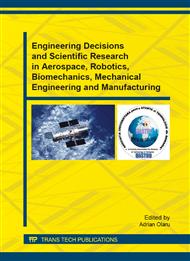[1]
J. Dufek, V. Adamek, Výzkum zátěže životního prostředí z dopravy. Výzkumná zpráva č.: CE 801 210 109 Brno: CDV (CZ), 2002, s. 63-71 (2002).
Google Scholar
[2]
M. Wilhelm, Materials used in automobile manufacture - current state and perspectives. JOURNAL DE PHYSIQUE IV, Colloque C7, supplkment au Journal de Physique III, Volume 3, novembre (1993).
DOI: 10.1051/jp4:1993703
Google Scholar
[3]
V. Overton Santford, J. Manura John, Identification Of Volatile Organic Compounds In a New Automobile. Scientific Instrument Services, Inc. http: /www. sisweb. com/referenc/ applnote/app-36-a. htm . Retrieved on July 9 (2005).
Google Scholar
[4]
S. Cornák, Selected problems of drivers microclimate. In: Transport Means 2009 – Proceedings of the 13th International Conference. Kaunas: Kaunas University of Technology, 2009, p.124 – 127. ISSN 1822-296X (2009).
Google Scholar
[5]
J. Velisek, Chemie potravin 3. Tábor: Ossis. 368. (2002).
Google Scholar
[6]
A. Jarosova, Zhodnocení výskytu ftalátů (1992–2009) v obalových materiálech a plastech, zdravotnických materiálech a krvi pacientů, v krmivech a potravinách a ve tkáních jatečných zvířat a ryb. Acta univ. agric. et silvic. Mendel. Brun. 58 (4), 263-268. ISSN 1211-8516 (2010).
DOI: 10.11118/actaun201058040263
Google Scholar
[7]
S. Cornak, A. Jarosova, The screening of phthalic acids esters in construction materials of vehicles. In: IV. Czech-Slovak Scientific Conference Transport, Health and Enviroment,. Tribun EU, Blansko, 2010, pp.91-96. ISBN 978-80-7399-141-8.
Google Scholar
[8]
http: /vydavatelstvi. vscht. cz/echo/organika/trivialni-sk-karboxylova_kyselina. html.
Google Scholar
[9]
http: /books. nap. edu/openbook. php?record_id=12528&page=14.
Google Scholar
[10]
M. Stuma: Phthalates in toys forbidden, in blood of suckling babies. Available on: http: /www. solen. cz/pdfs/int/2007/06/09. pdf, Retrieved on July 20, 2013, [In Czech].
Google Scholar
[11]
G. Latini, Monitoring phthalate exposure in human. Clinica Chimica Acta, International Journal of Clinical Chemistry, 361(1-2), 2005, pp.20-29.
DOI: 10.1016/j.cccn.2005.05.003
Google Scholar
[12]
J. Velisek, Chemistry of groceries 3. OSSIS, Tábor, 2002, 368 s., ISBN 80-86659-02-X [In Czech].
Google Scholar
[13]
U. Heudorf u., V. Mersch-sundermann, J. Angerer, Phthalates: Toxicology and exposure. International Journal of Hygiene and Environmental Health, 210 (5), 2007, p.623−634.
DOI: 10.1016/j.ijheh.2007.07.011
Google Scholar
[14]
A. Jarosova, Phthalic acid esters (PAEs) in the food chain. Czech Journal of Food Science. 24 (5), Praha 200, pp.223-231, ISSN 1212-1800.
DOI: 10.17221/3318-cjfs
Google Scholar
[15]
A. Jarosova, J. Harazim, L. Kratka, D. Kolencikova, Phthalates contamination level in sampled feeding materials, additive materials and premixes. Maso, 19 (1), Praha 2008, p.84−86. ISSN 1210-4086 [In Czech].
Google Scholar
[16]
T. Schettler, N. E. Skakkebaek, D. De Kretser, H. Leffers, Human exposure to phthalates via consumer products. International Journal of Andrology, 29 (1), 2006, p.134−139.
DOI: 10.1111/j.1365-2605.2005.00567.x
Google Scholar
[17]
T. Salthammer, M. Bahadir, Occurrence, Dynamics and Reactions of Organic Pollutants in the Indoor Environment. Clean, 37(6), 2009, pp.417-435.
DOI: 10.1002/clen.200900015
Google Scholar
[18]
C. J. Hines, et al, urinary phthalate metabolite concentrations among workers in selected industries: a pilot bio monitoring study. Oxford univ press, great clarendon st, Oxford ox2 6dp, Oxford, 2009, pp.1-17, ISSN: 0003-4878.
Google Scholar
[19]
M. Wormuth, M. Scheringer, M. Vollenweider, K. Hungerbühler, What are the sources of exposure to eight frequently used phthalic acid esters in Europeans? Risk Analysis, 26 (3), 2006, pp- 803−824.
DOI: 10.1111/j.1539-6924.2006.00770.x
Google Scholar
[20]
L. Oie, L. G. Hersoug & J. O. Madsen, Residential exposure to plasticizers and its possible role in the pathogenesis of asthma. Environmental Health Perspectives, 1997, 105: 972 – 978, ISSN 0091-6765.
DOI: 10.1289/ehp.97105972
Google Scholar
[21]
M. Matsumoto, M. Hirata-koizumi, M. Ema, Potential adverse effects of phthalic acid esters on human health: A review of recent studies on reproduction. Regulatory Toxicology Pharmacology 50 (1), 2008, p.37−49.
DOI: 10.1016/j.yrtph.2007.09.004
Google Scholar
[22]
D. Valis, L. Zak, J. Glos, A. Walek, Contribution to Mathematical Modelling of Oil Field Data. In: Periodical of Applied Mechanics and Materials. Zurich-Durnten, Switzerland: Trans Tech Publications, Zurich, 2013, pp.455-462.
DOI: 10.4028/www.scientific.net/amm.332.455
Google Scholar
[23]
A. Jarosova, V. Gajduskova, J. Raszyk, K. Sevela, Di-2-ethylhexyl phthalate and di-n-butyl phthalate in the tissues of pigs and broiler chicks after their oral administration. Vet. Med. - Czech, Praha, 1999; pp- 61 - 70.
Google Scholar
[24]
Law No. 110/1997 of digests about groceries and tobacco products and about the change and completion some related laws [In Czech].
Google Scholar


